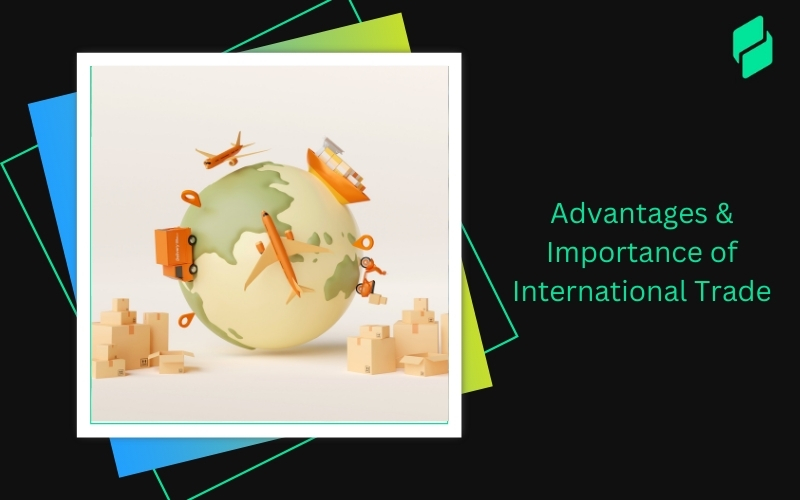Optimize your business: use unlimited savings with Pazago fulfilled now!
Get Started ->Have you ever paused to consider how the latest smartphone arrived at your doorstep from halfway across the world? Or how are coffee beans from South America available in your local supermarket?
The answer lies in the complex and fascinating world of global shipping—a critical cog in the machinery of international trade.
Global Shipping Defined
Global shipping encompasses transporting goods internationally by sea, air, or land, connecting markets worldwide.
It involves a network of freight forwarders, logistics providers, customs agents, and shipping lines that work together to move goods from manufacturers to markets.
The scope of global shipping is vast, encompassing everything from small parcel deliveries to massive container ships carrying thousands of tons of cargo.
The Crucial Role of Global Shipping in International Trade
Global shipping is the backbone of international trade. Without it, economies would grind to a halt. It allows countries to import domestically unavailable goods, export goods to expand markets, and leverage competitive advantages in cost and quality.
It also supports economic growth, creates jobs, and fosters connectivity between countries, making it a pivotal element in the global economy.
Also Read: Understanding Ocean Shipping and Transport Services
The Evolution of Global Shipping
The history of global shipping is a testament to human ingenuity and the quest for economic expansion. From the ancient maritime silk routes to the modern-day mega-ships and digital tracking systems, shipping has evolved dramatically.
For example, the container revolution in the mid-20th century transformed ship design and port structure, dramatically increasing efficiency and lowering the cost of cargo transport.
This evolution continues today with innovations in eco-friendly shipping technologies and logistics and freight forwarding automation.
Exploring the Spectrum of Global Shipping Services
Here’s a breakdown of the primary services that keep the wheels of global commerce turning.
1. Freight Shipping
Freight shipping is the lifeblood of the international trade system, handling the bulk movement of goods across oceans and continents. This service typically involves the transportation of large quantities of goods using various modes such as ships, trains, and trucks.
For businesses, choosing the right type of freight—whether ocean freight, air freight, or land freight—depends on factors like cost, transit time, and the nature of the goods. Engaging in effective freight shipping practices ensures that your products reach their destination safely and efficiently, solidifying your standing in the global market.
2. Parcel Shipping
Parcel shipping caters to smaller, lighter shipments and is integral to e-commerce and small enterprises looking to reach customers worldwide. This type of service is typically faster than freight shipping and is handled by global courier companies that offer door-to-door service.
It's ideal for sending sample products, documents, and other small goods that require quick delivery times. By optimising parcel shipping strategies, you can enhance customer satisfaction through timely deliveries and detailed tracking capabilities.
3. Express and Courier Services
Express and courier services provide rapid and reliable shipping solutions when the time comes. These services are critical for urgent shipments, including time-sensitive documents, medical supplies, or last-minute parts needed for production.
Express shipping offers speed, enhanced security, detailed tracking, and confirmed delivery times. This service is precious for businesses that require agility and precision in their logistics operations.
Choosing the Right Mode of Transportation in Global Shipping
When it comes to global shipping, selecting the optimal mode of transportation is not just about speed; it’s about matching your logistical needs with the characteristics of your cargo.
Understanding each mode's strengths and limitations can significantly enhance your shipping strategy as you consider options.
1. Ocean Freight: The Pillar of International Trade
Ocean freight is the backbone of global shipping, handling over 90% of international trade. Due to its vast capacity, it's particularly cost-effective for transporting large volumes of goods.
Ocean freight offers a reliable and economical option, whether you're shipping containers of electronics or bulk commodities like oil or grain. However, while it excels in cost-effectiveness, it is generally slower than other modes, making it ideal for goods that are not time-sensitive.
Also Read: Understanding Ocean Transport: Maritime and Bulk Freight Shipping
2. Air Freight: Speed When It Matters Most
Air freight is your go-to for speed and reliability. It's perfect for high-value, low-volume shipments or urgent deliveries like pharmaceuticals and perishable goods.
The main advantage of air freight is its fast delivery times, which can be crucial for maintaining the freshness of goods or keeping production lines running smoothly. However, this speed comes at a premium, making it more expensive than ocean freight.
Also Read: Understanding Dimensions and Weight in Air Freight Shipments
3. Rail Transport: Efficient Overland Movement
Rail transport is a key player in the land-based shipping landscape. It offers an excellent balance of speed and cost, particularly across vast distances like the United States, India, Russia or China. It’s more environmentally friendly and often quicker than road transport for long-distance hauls.
Rail is ideal for transporting heavy, bulky goods such as coal, steel, and wood. It’s a reliable choice for businesses looking for cost-efficient yet faster-than-sea transport solutions.
Also Read: Shipping Heavy Freight: A Look at Services and Procedures
4. Road Transport: Versatility and Accessibility
Road transport is arguably the most flexible mode of transportation. It provides door-to-door service and is essential for the final leg of most shipping routes, known as the "last mile" delivery.
It's ideal for shorter distances and smaller loads and provides the convenience of easy scheduling and route modification to meet dynamic shipping needs. Road transport, such as consumer retail goods, is crucial for urban deliveries and services with tight deadlines.
Also Read: Understanding Transportation Charges and Their Different Types
The Impact of Logistics and Supply Chain Management on Global Shipping
Let's explore how integrated logistics strategies enhance operational efficiency and drive the global shipping industry forward.
1. Role of Logistics in Shipping
In global shipping, logistics ensures that every piece of the puzzle, from freight forwarding to customs clearance, aligns perfectly to facilitate smooth transit.
By effectively managing logistics, companies can reduce shipping delays and costs, ensuring products arrive at their destinations efficiently and economically. This efficiency is crucial for maintaining competitiveness in international markets.
2. Inventory Management
Effective inventory management is pivotal in optimising the supply chain. It involves forecasting demand, ensuring adequate stock levels, and minimising excess inventory to reduce holding costs.
Sophisticated inventory systems can track product availability in real time, enabling businesses to make informed decisions on restocking and production schedules. This precision prevents product shortages and ensures resources are allocated wisely, maximising profitability.
Also Read: Operations and Supply Chain Management- A Pazago’s Guide
3. Warehousing Solutions
Warehousing is more than just storing goods; it’s about smart placement and turnover of products to support seamless distribution.
Modern warehousing solutions incorporate advanced technologies such as automated retrieval systems and robotics to enhance the speed and accuracy of picking and packing processes.
Efficient warehousing ensures that goods are well-preserved, properly organised, and ready for prompt distribution, which is essential for maintaining service levels in global shipping.
4. Distribution Networks
The final piece of the logistics puzzle is the distribution network, which is critical for delivering goods to end customers.
Robust distribution networks leverage multimodal transport systems that integrate ocean, air, rail, and road transport to offer flexible, cost-effective shipping solutions.
By optimising route planning and delivery schedules, businesses can enhance delivery speeds and reduce transportation costs, improving overall customer satisfaction.
Also Read: Understanding Integrated Logistics Management System and its Benefits
Global Shipping Regulations and Compliance
Let’s explore how staying abreast of these regulations can safeguard your shipments and streamline your operations.
1. International Shipping Regulations
Navigating international shipping waters requires a thorough understanding of the diverse regulations set by different countries. These regulations ensure that ships comply with safety, environmental, and security standards for protecting the marine ecosystem and international waters.
Compliance means fewer delays, less risk of penalties, and a reputation for reliability and safety for you, the shipper. Staying updated with international maritime laws, such as SOLAS (Safety of Life at Sea) and MARPOL (Marine Pollution), is crucial for smooth operations in global shipping.
2. Customs and Documentation
Meticulous customs procedures and documentation underpin effective global shipping. It is vital to ensure that all paperwork is accurately completed and compliant with the regulations of the importing and exporting countries. This includes correctly filled bills of lading, shipper’s export declarations, and commercial invoices.
Custom documents must accurately reflect the shipment's contents to avoid delays, fines, or cargo seizures. Simplifying these processes through digital solutions can significantly enhance efficiency and reduce errors, making your shipping operations more reliable and less prone to customs hold-ups.
3. Trade Agreements and Tariffs
Trade agreements and tariffs play a pivotal role in shaping the dynamics of global shipping. These agreements can either lower trade barriers, making shipping processes smoother and more cost-effective or impose tariffs that increase costs.
It is essential to understand how various trade agreements, such as NAFTA (North American Free Trade Agreement) or the European Union’s trade policies, affect your shipping routes and costs.
This knowledge allows you to strategise effectively, choosing routes that optimise costs and compliance and ensuring that your goods move through borders as efficiently as possible.
Also Read: Definition, Types, and Effects of Tariffs in International Trade
Challenges in Global Shipping
As the arteries of international trade, global shipping faces myriad challenges that can impede the flow of goods across borders.
From environmental concerns to unexpected global disruptions, navigating these waters requires resilience and strategic foresight. Here’s how you, as a stakeholder in global shipping, can address these challenges effectively.
1. Environmental Impact
The shipping industry significantly contributes to marine pollution and greenhouse gas emissions. As a key player in global shipping, your commitment to environmental sustainability is not just good ethics—it's good business.
Adopting cleaner fuel alternatives, optimising shipping routes for fuel efficiency, and investing in newer, greener technologies can help mitigate the environmental impact.
These practices comply with increasing regulatory pressures and resonate with eco-conscious consumers, enhancing your brand's reputation.
2. Risk Management and Security
The vast expanse of routes covered by global shipping exposes cargo to various risks—from piracy and theft to damage from rough seas. Implementing robust security measures and risk management strategies is essential.
This includes thorough crew and security personnel vetting, investing in advanced tracking systems, and insurance coverage that protects against potential losses. By fortifying your operations against these risks, you ensure smoother and more secure client transactions.
Also Read: Understanding and Reducing Logistics Costs: Types and Measurement Methods
3. Cost Management
Effective cost management is crucial in an industry with thin profit margins. Fluctuating fuel prices, varying freight rates, and unexpected expenses like demurrage and detention fees can all erode profits.
Streamlining operations, negotiating better terms with freight carriers, and utilising digital tools to optimise routes and manage operations can help control costs. Regularly reviewing your supply chain for inefficiencies and potential savings is critical to maintaining competitiveness in the global market.
Also Read: How To Reduce Container Shipping Costs
4. Pandemic and Disruptions
The recent global pandemic has underscored the vulnerability of global supply chains to major disruptions. Key strategies for building resilience against such impacts include diversifying suppliers, increasing inventory buffers, and developing contingency plans.
Embracing flexibility and adapting to changing scenarios quickly can help minimize disruptions, ensuring your supply chain remains robust even in uncertain times.
Also Read: Top 10 Emerging Trends in Digital Supply Chain Management 2024
Emerging Trends in Global Shipping
As we sail into the future, the global shipping industry is poised for a transformative era. Technology, environmental concerns, and evolving market demands reshape how goods traverse our oceans and skies.
Here’s what you need to know about the dynamic future awaiting global shipping.
1. Sustainable Shipping Practices
The shipping industry is steering towards sustainability in response to increasing environmental awareness. The future will see a greater emphasis on reducing emissions through alternative fuels like LNG (liquefied natural gas) and hydrogen and improving energy efficiency with advanced ship designs.
Investing in these technologies not only complies with tightening global regulations but also positions your business as a leader in responsible shipping.
2. Tracking and Monitoring Systems
The digital revolution has ushered in sophisticated tracking and monitoring systems that provide real-time shipment data.
These technologies enhance transparency and improve the accuracy of logistics management. In the coming years, expect these systems to become more integrated and capable of predictive analytics, helping you anticipate and solve potential issues before they impact your supply chain.
Also Read: Also Read: Top Supply Chain Management Software Tools
3. Automation and Robotics
Automation is set to redefine the operational aspects of shipping. From automated ports and robotic loading and unloading systems to autonomous ships, these technologies promise to boost efficiency and reduce human error.
Embracing automation can significantly cut operational costs and improve turnaround times, giving you a competitive edge in the fast-paced shipping industry.
4. The Role of E-commerce and Digital Platforms
E-commerce growth is transforming shipping demands, increasing the need for faster, more reliable delivery services. Digital platforms are becoming integral in managing these demands, offering streamlined services from booking to delivery.
Adapting to these platforms enables better service offerings and accessibility for your business, making it easier to meet customer expectations in a digital-first world.
5. Evolution of Customer Expectations
As digital natives become a larger part of the consumer base, expectations for shipping services are evolving. Customers now expect faster, more transparent, and more customisable shipping options.
To stay ahead, you’ll need to continuously innovate and adapt, ensuring your shipping solutions align with customer demands for speed, flexibility, and eco-consciousness.
Streamlining Global Shipping with Pazago: Your Ultimate Trade Management Solution
Managing export-import operations can be complex, but Pazago simplifies everything. With support across 110+ countries, Pazago delivers an impressive 20% cost saving and 50% reduction in turnaround time (TAT), making it an essential tool for businesses involved in global trade.

As an advanced EXIM trade management platform, Pazago empowers businesses to manage, automate, and optimise global trade processes from a single, integrated portal.
Key Features of Pazago:
- Digital Trade Management: Streamline your entire trade process from procurement to fulfilment with real-time tracking and clear communication channels.
- Efficient Order Handling: Eliminate paperwork and centralise information to manage purchase orders swiftly and effectively.
- Proactive Planning: Get notifications and auto-reminders to plan your inventory and processes, avoiding delays and bottlenecks.
- Centralised Communication: Bring all key parties into one conversation with Pazago's Inbox, making trade discussions clear and efficient.
- Document Management: Create, manage, and collaborate on critical trade documents like quotations and certificates of origin, all in one secure place.
- Real-Time Cargo Tracking: Monitor shipments globally with just a BL number, covering over 180 shipping companies in 110+ countries.
- Seamless Payment Processing: Enjoy quick international payments with priority clearance and low Forex rates, receiving funds in three hours.
- Reliable Logistics: Access cost-effective cross-border logistics with seamless customs clearance, including ocean shipping and in-land transportation.
- Comprehensive Insurance: Secure your shipments with digital insurance options, offering easy claims without unnecessary paperwork.
Why Choose Pazago?

Pazago is your go-to platform for simplifying global trade operations, reducing risks, and ensuring your shipments reach their destination smoothly and securely. It’s the all-in-one solution for businesses looking to enhance their international trade efficiency.


.png)








